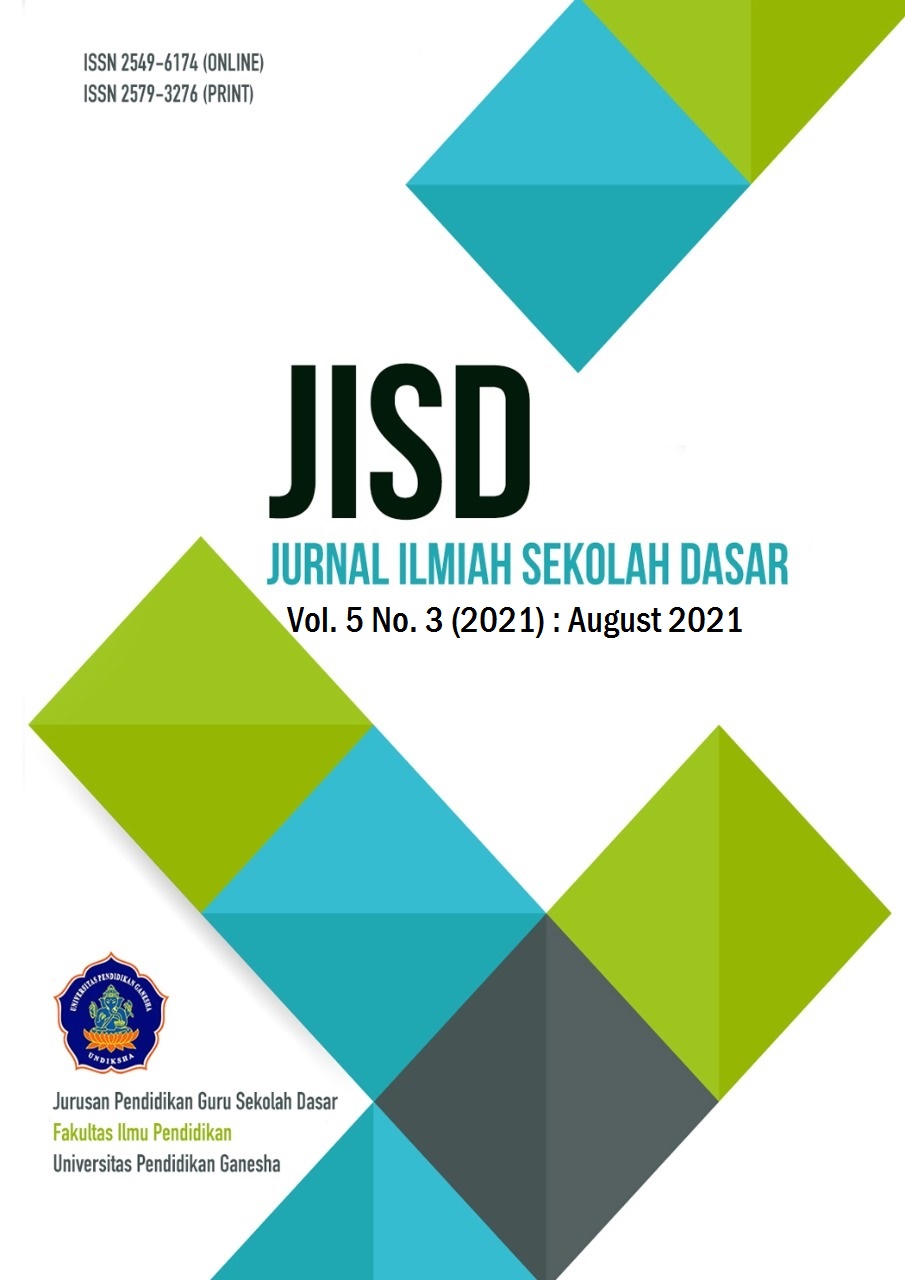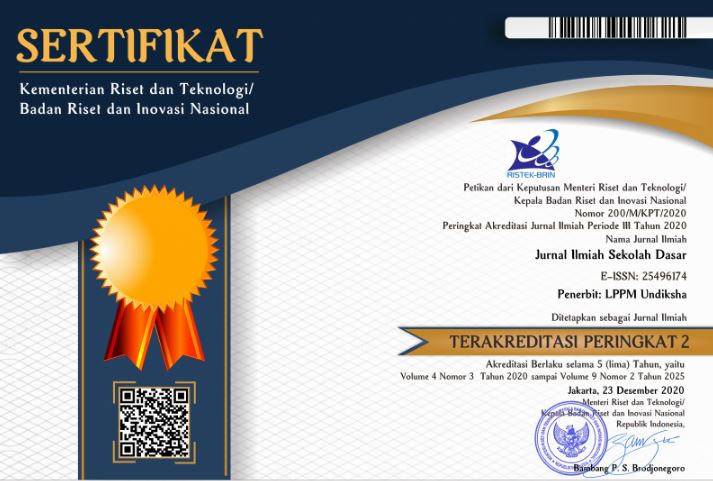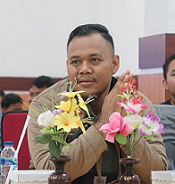The Development, Transformation, and Use of The Children's Language
DOI:
https://doi.org/10.23887/jisd.v5i3.40016Kata Kunci:
language transformation, kindergarten childrenAbstrak
There are still many children who have difficulty learning foreign languages. In addition, children also have difficulty in memorizing foreign language vocabulary. Language development for children has a dynamic nature because many factors can influence it. This study aims to identify various forms of language development and transformation experienced by students and students of TPA. This type of research is qualitative research. The research method used in this study is a case study on the development, transformation, and use of language by children who are members of TPA students. This case study was conducted to identify the phenomenology of dynamic use and development of children's language through the TPA program. Data were collected through observation and interviews. The data analysis technique is descriptive qualitative analysis. The study results indicate that there is a development, transformation, and use of a unique and exciting language that is influenced by the context of TPA as the realm of informal education based on Islamic education. This is evident from the various forms of language used by children who experience vocabulary development until they are transformed into code-switching and Arabic code-mixing. The use of Arabic can be seen as an opportunity because it can increase children's knowledge and vocabulary, but at the same time, it can also be seen as a threat to the survival of the mother tongue and national language for children.
Referensi
Akbar, A. (2015). Pemerolehan Morfem Afiks Bahasa Indonesia Anak Usia 2-6 Tahun Di Paud Buana Desa Banyu Urip Kabupaten Lombok Tengah. RETORIKA: Jurnal Bahasa, Sastra, Dan Pengajarannya, 1(2). https://doi.org/10.22225/jr.1.2.32.250-257. DOI: https://doi.org/10.22225/jr.1.2.32.250-257
Alam, S. K., & Lestari, R. H. (2020). Pengembangan Kemampuan Bahasa Reseptif Anak Usia Dini dalam Memperkenalkan Bahasa Inggris melalui Flash Card. Jurnal Obsesi : Jurnal Pendidikan Anak Usia Dini, 4(1), 284. https://doi.org/10.31004/obsesi.v4i1.301. DOI: https://doi.org/10.31004/obsesi.v4i1.301
Alghazo, S., Zemmour, S., Salem, M. N. Al, & Alrashdan, I. (2021). A cross-cultural analysis of the speech act of congratulating in Kabyle and Jordanian Arabic. Ampersand, 8. https://doi.org/10.1016/j.amper.2021.100075. DOI: https://doi.org/10.1016/j.amper.2021.100075
Almaiah, M. A., Al-Khasawneh, A., & Althunibat, A. (2020). Exploring the critical challenges and factors influencing the E-learning system usage during COVID-19 pandemic. Education and Information Technologies, 25(6), 5261–5280. https://doi.org/10.1007/s10639-020-10219-y. DOI: https://doi.org/10.1007/s10639-020-10219-y
Andrade, M. S., Evans, N. W., & Hartshorn, K. J. (2014). Linguistic support for non-native English speakers: Higher education practices in the United States. Journal of Student Affairs Research and Practice, 51(2). https://doi.org/10.1515/jsarp-2014-0020. DOI: https://doi.org/10.1515/jsarp-2014-0020
Ang, S., Embi, M. A., & Yunus, M. M. (2017). Strategies of Successful English Language Learners among Private School Students. Jurnal Pendidikan Humaniora, 5(2), 47–57. https://doi.org/10.17977/um030v5i22017p047. DOI: https://doi.org/10.17977/um030v5i22017p047
Cekaite, A. (2017). What Makes a Child a Good Language Learner? Interactional Competence, Identity, and Immersion in a Swedish Classroom. Annual Review of Applied Linguistics, 37, 45–61. https://doi.org/10.1017/S0267190517000046. DOI: https://doi.org/10.1017/S0267190517000046
Djou, D. N., & Ntelu, A. (2021). Bahasa Gorontalo dan Bahasa Suwawa pada Anak Usia Dini. Jurnal Obsesi, 5(2). https://doi.org/10.31004/obsesi.v5i2.895. DOI: https://doi.org/10.31004/obsesi.v5i2.895
Fauzi, M. F., Buhun, M. F., & Purwadi, A. (2019). The Influence of Teams Games Tournament (TGT) toward Students’ Interest in Arabic Language Learning. Journal Of Arabic Languange Teaching, Linguistic and Literate, 2(2). https://doi.org/10.22219/jiz.v2i2.9986. DOI: https://doi.org/10.22219/jiz.v2i2.9986
Fuad, Z. Al, & Helminsyah. (2018). Language Experience Approach Sebuah Pendekatan Dalam Meningkatkan Keterampilan Menulis Siswa Sekolah Dasar. Jurnal Tunas Bangsa, 5(2), 164–174. https://doi.org/10.46244/tunasbangsa.v8i1. DOI: https://doi.org/10.46244/tunasbangsa.v8i1
Guo, L., & Zhao, Z. (2002). Children, gender, and language teaching materials. Chinese Education and Society, 35(5), 34–52. https://doi.org/10.2753/ced1061-1932350534. DOI: https://doi.org/10.2753/CED1061-1932350534
Hariati, P. H. (2020). Illocutionary Acts in Jack Ma’s Inspiring Speech in His Graduation at The University of Hongkong. Britain International of Linguistics, Arts and Education, 2. https://doi.org/10.33258/biolae.v2i1.209. DOI: https://doi.org/10.33258/biolae.v2i1.209
Hasan, A. A., & Baroroh, U. (2019). Pengembangan Media Pembelajaran Bahasa Arab Melalui Aplikasi Videoscribe Dalam Meningkatkan Motivasi Belajar Siswa. Lisanuna: Jurnal Ilmu Bahasa Arab Dan Pembelajarannya, 9(2). https://doi.org/10.22373/ls.v9i2.6738. DOI: https://doi.org/10.22373/ls.v9i2.6738
House, J., Kádár, D. Z., Liu, F., & Bi, Z. (2021). Altered speech act indication: A problem for foreign language learners? System, 101. https://doi.org/10.1016/j.system.2021.102554. DOI: https://doi.org/10.1016/j.system.2021.102554
Hulukati, W., Rahim, M., & Djafar, Y. (2017). Pembelajaran Bahasa Daerah Gorontalo Pada Anak Usia Dini. VISI: Jurnal Ilmiah Pendidik Dan Tenaga Kependidikan Pendidikan Non Formal, 12(1). https://doi.org/10.21009/JIV.1201.8. DOI: https://doi.org/10.21009/JIV.1201.8
Iannuccilli, M., Dunfield, K. A., & Byers-Heinlein, K. (2021). Bilingual children judge moral, social, and language violations as less transgressive than monolingual children. Journal of Experimental Child Psychology, 208. https://doi.org/10.1016/j.jecp.2021.105130. DOI: https://doi.org/10.1016/j.jecp.2021.105130
Khong, H. K., Hassan, N. H., & Ramli, N. (2017). Motivation and gender differences in learning Spanish as a foreign language in a Malaysian Technical University. Malaysian Journal of Learning and Instruction. https://doi.org/10.32890/mjli2017.14.2.3. DOI: https://doi.org/10.32890/mjli2017.14.2.3
Khotimah, K., Widiati, U., Mustofa, M., & Faruq Ubaidillah, M. (2019). Autonomous English learning: Teachers’ and students’ perceptions. Indonesian Journal of Applied Linguistics, 9(2), 371–381. https://doi.org/10.17509/ijal.v9i2.20234. DOI: https://doi.org/10.17509/ijal.v9i2.20234
Kurnia, D., Taufiq, M., & Silawati, E. (2015). Analisis Capaian Perkembangan Bahasa Anak Usia Dini Dalam Kegiatan Pembelajaran Dengan Metode Learning Based Resources. Cakrawala Dini: Jurnal Pendidikan Anak Usia Dini, 6(2). https://doi.org/10.17509/cd.v6i2.10520. DOI: https://doi.org/10.17509/cd.v6i2.10520
Kurniawati, D. (2019). Keefektifan Pengajaran Kosakata Bahasa Inggris Pada Anak Sekolah Dasar Dengan Menggunakan Flash Card. Jurnal Pendidikan Dan Pembelajaran Dasar, 2(2), 59. https://doi.org/10.37484/manajemen_pelayanan_hotel.v2i2.40. DOI: https://doi.org/10.37484/manajemen_pelayanan_hotel.v2i2.40
Lai, C., & Tai, C.-P. (2021). Types of social media activities and Hong Kong South and Southeast Asians Youth’s Chinese language learning motivation. System, 97. https://doi.org/10.1016/j.system.2020.102432. DOI: https://doi.org/10.1016/j.system.2020.102432
Liyana, A., & Kurniawan, M. (2019). Speaking Pyramid sebagai Media Pembelajaran Kosa Kata Bahasa Inggris Anak Usia 5-6 Tahun. Jurnal Obsesi : Journal of Early Childhood Education, 3(1). https://doi.org/10.31004/obsesi.v3i1.178. DOI: https://doi.org/10.31004/obsesi.v3i1.178
Mauliate, H. D., Rahmat, A., & Wachidah, S. (2019). Evaluation the Lesson Plan of English Language Learning in Junior High School, Seraphine Bakti Utama West Jakarta. International Journal of Scientific Research and Management, 7(07), 1078–1086. https://doi.org/10.18535/ijsrm/v7i7.el02. DOI: https://doi.org/10.18535/ijsrm/v7i7.el02
Miles, & Huberman. (2007). Analisis Data Kualitatif. Universitas Inggris.
Muhonen, H., Pakarinen, E., Lerkkanen, M.-K., Barza, L., & Suchodoletz, A. von. (2020). Patterns of dialogic teaching in kindergarten classrooms of Finland and the United Arab Emirates. Learning, Culture and Social Interaction, 25. https://doi.org/10.1016/j.lcsi.2018.11.011. DOI: https://doi.org/10.1016/j.lcsi.2018.11.011
Mulyaningtyas, R. (2019). Stimulasi Dalam Memaksimalkan Kemampuan Berbahasa Anak Usia Dini. Martabat: Jurnal Perempuan Dan Anak, 3(1). https://doi.org/10.21274/martabat.2019.3.1.121-140. DOI: https://doi.org/10.21274/martabat.2019.3.1.121-140
Ninoersy, & Akmal. (2020). Penerapan Pola Perkuliahan Muhadatsah Melalui Metode Debat Aktif Pada Prodi Pendidikan Bahasa Arab Fakultas Tarbiyah Dan Keguruan Uin Ar-Raniry Banda Aceh. Jurnal Ilmiah Didaktika: Media Ilmiah Pendidikan Dan Pengajaran, 20(2), 165 – 188. https://doi.org/10.22373/jid.v20i2.5478. DOI: https://doi.org/10.22373/jid.v20i2.5478
Nuraeni, S., Maesaroh, A., & Sumitra, A. (2019). Optimalisasi Keterampilan Berbicara Untuk Meningkatkan Keyakinan Diri Anak Usia Dini Di Tk Baiturrahman Kabupaten Bandung. CERIA (Cerdas Energik Responsif Inovatif Adaptif), 2(4). https://doi.org/10.22460/ceria.v2i4.p166-172. DOI: https://doi.org/10.22460/ceria.v2i4.p166-172
Parvareshbar, F., & Ghoorchaei, B. (2016). The Effect of Using Short Stories on Vocabulary Learning of Iranian EFL Learners. Theory and Practice in Language Studies, 6(7), 1476. https://doi.org/10.17507/tpls.0607.20. DOI: https://doi.org/10.17507/tpls.0607.20
Paul, R., & Singh, A. (2020). Does early childhood adversities affect physical, cognitive and language development in indian children? Evidence from a panel study. SSM - Population Health, 12(August), 100693. https://doi.org/10.1016/j.ssmph.2020.100693. DOI: https://doi.org/10.1016/j.ssmph.2020.100693
Putri, W. N. (2017). Pengaruh Media Pembelajaran Terhadap Motivasi Belajar Bahasa Arab Siswa Madrasah Tsanawiyah. LISANIA: Journal of Arabic Education and Literature, 1(1), 1–16. https://doi.org/10.18326/lisania.v1i1.1160. DOI: https://doi.org/10.18326/lisania.v1i1.1-16
Rahmat, A., & Akbar, M. (2019). A Comparative Analysis of English Learning Motivation between the Rural and Urban Students. Metathesis: Journal of English Language, Literature, and Teaching, 3(2), 158. https://doi.org/10.31002/metathesis.v3i2.1740. DOI: https://doi.org/10.31002/metathesis.v3i2.1740
Ratajczak, M. (2018). Language and value: the philosophy of language in the post-Operaist critique of contemporary capitalism. Language Sciences, 17. https://doi.org/10.1016/j.langsci.2018.08.004. DOI: https://doi.org/10.1016/j.langsci.2018.08.004
Rosalina, A. (2011). Peningkatan Kemampuan Bahasa Anak Usia Dini Melalui Kegiatan Bermain. Psycho Idea, 9(1), 19–35. https://doi.org/10.30595/psychoidea.v9i1.239.
Sharif Matthews, J., & López, F. (2019). Speaking their language: The role of cultural content integration and heritage language for academic achievement among Latino children. Contemporary Educational Psychology, 57, 72–86. https://doi.org/10.1016/j.cedpsych.2018.01.005. DOI: https://doi.org/10.1016/j.cedpsych.2018.01.005
Sokolova, E. Y., Golovacheva, E. A., & Chernaya, A. A. (2018). Professionally-Oriented Communicative Language Teaching Approach by the Design of a Computer Assisted ESP Course: Analysis of Results. Procedia - Social and Behavioral Sciences, 215. https://doi.org/10.1016/j.sbspro.2015.11.619. DOI: https://doi.org/10.1016/j.sbspro.2015.11.619
Su, H., Zhang, Y., & Lu, X. (2021). Applying local grammars to the diachronic investigation of discourse acts in academic writing: The case of exemplification in Linguistics research articles. English for Specific Purposes, 63. https://doi.org/10.1016/j.esp.2021.05.002. DOI: https://doi.org/10.1016/j.esp.2021.05.002
Suardi, I. P., Ramadhan, S., & Asri, Y. (2019). Pemerolehan Bahasa Pertama pada Anak Usia Dini. Jurnal Obsesi : Journal of Early Childhood Education, 3(1). https://doi.org/10.31004/obsesi.v3i1.160. DOI: https://doi.org/10.31004/obsesi.v3i1.160
Sun, T., Wang, C., Lambert, R. G., & Liu, L. (2021). Relationship between second language English writing self-efficacy and achievement: A meta-regression analysis. Journal of Second Language Writing, 53. https://doi.org/10.1016/j.jslw.2021.100817. DOI: https://doi.org/10.1016/j.jslw.2021.100817
Trisnanti, I. A. N. L., Tirtayani, L. A., & Putra, I. K. A. (2018). Pengaruh Media Flashcard Bilingual Terhadap Kemampuan Kosakata Bahasa Inggris Permulaan Anak Kelompok B TK Gugus Mawa. Journal Pendidikan Anak Usia Dini Undiksha, 6(3), 346. https://doi.org/10.23887/paud.v6i1.15200. DOI: https://doi.org/10.23887/paud.v6i1.15200
Triutami, I. G. A. A. D., Sudhita, I. W. R., & Tegeh, I. M. (2014). Penerapan Metode Bercerita Berbantuan Media Boneka Tangan Untuk Meningkatkan Perkembangan Bahasa Pada Anak. Jurnal Pendidikan Anak Usia Dini, 2(1). https://doi.org/10.23887/paud.v2i1.3239.
Wijayanti, D. N. (2019). Effective learning of English through children’s songs for madrasah ibtidaiyah (MI) students. Elementary, 4(1), 124–148. https://doi.org/10.21043/elementary.v4i1.1931. DOI: https://doi.org/10.21043/elementary.v4i1.1931
Zarei, A. A., & Afshar, N. S. (2014). Multiple Intelligences As Predictors Of Reading Comprehension And Vocabulary Knowledge. Indonesian Journal Of Applied Linguistics, 4(1). https://doi.org/10.17509/ijal.v4i1.598. DOI: https://doi.org/10.17509/ijal.v4i1.598
Unduhan
Diterbitkan
Cara Mengutip
Terbitan
Bagian
Lisensi
Authors who publish with the Journal Ilmiah Sekolah Dasar agree to the following terms:
- Authors retain copyright and grant the journal the right of first publication with the work simultaneously licensed under a Creative Commons Attribution License (CC BY-SA 4.0) that allows others to share the work with an acknowledgment of the work's authorship and initial publication in this journal.
- Authors are able to enter into separate, additional contractual arrangements for the non-exclusive distribution of the journal's published version of the work (e.g., post it to an institutional repository or publish it in a book), with an acknowledgment of its initial publication in this journal.
- Authors are permitted and encouraged to post their work online (e.g., in institutional repositories or on their website) prior to and during the submission process, as it can lead to productive exchanges, as well as earlier and greater citation of published work. (See The Effect of Open Access)










